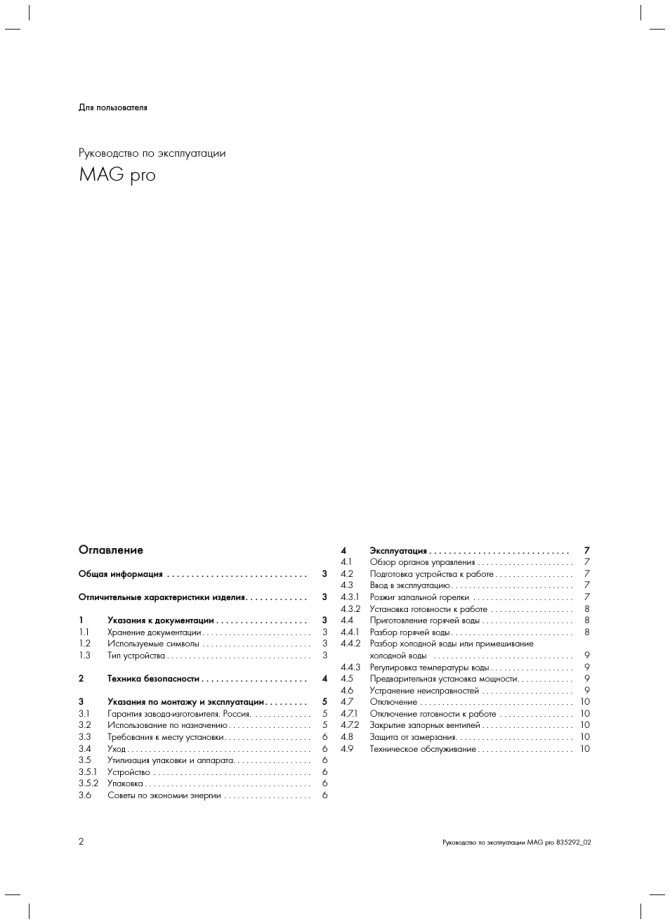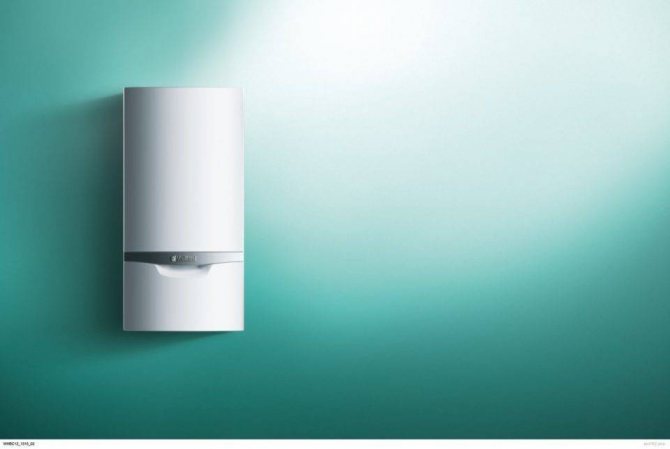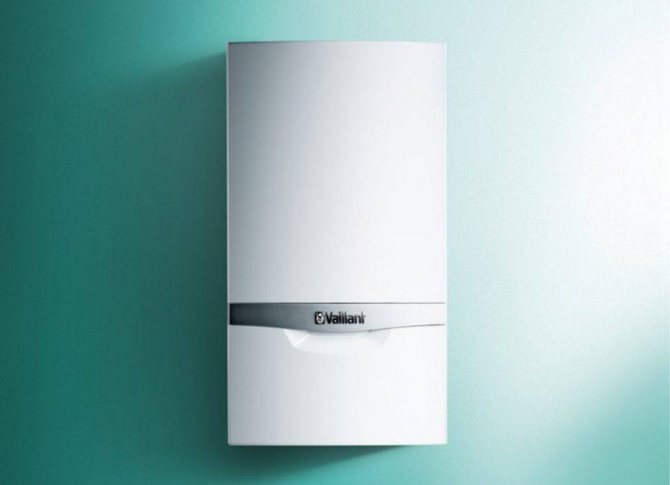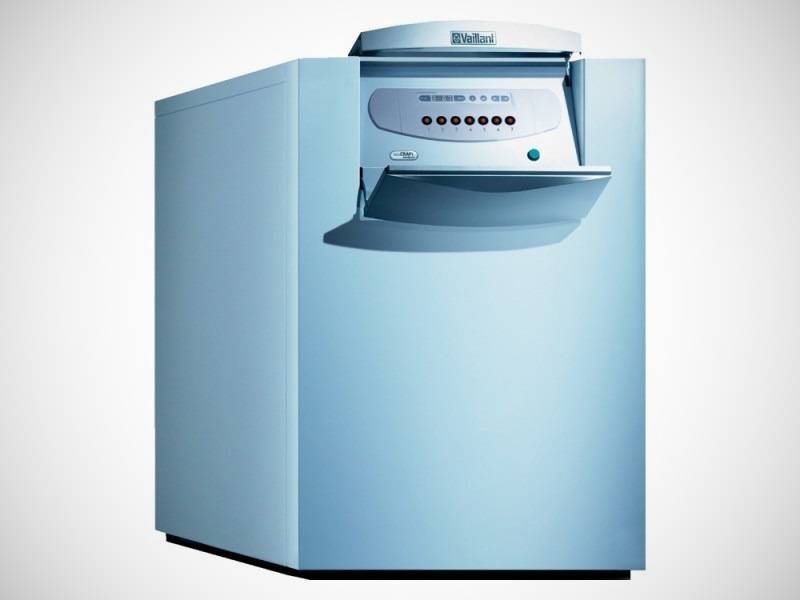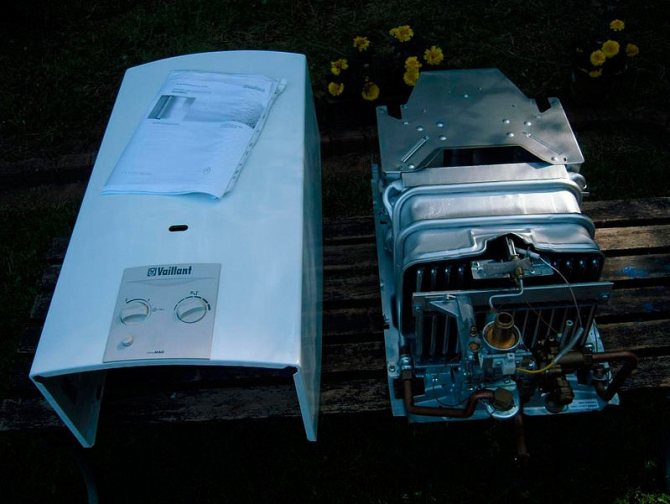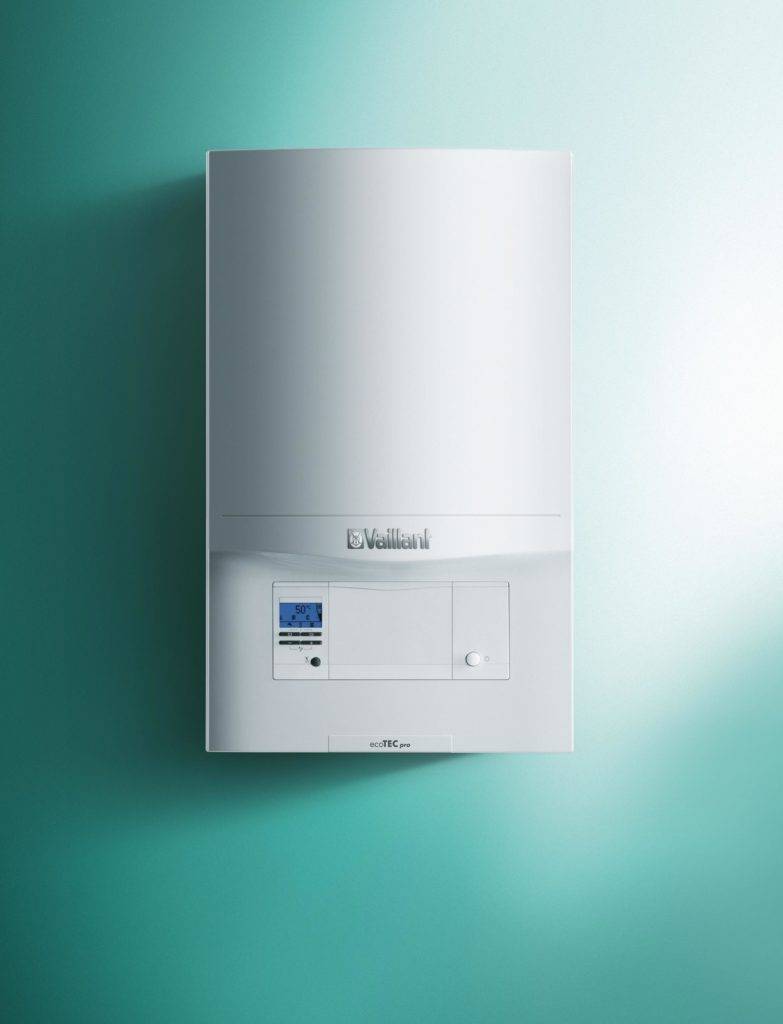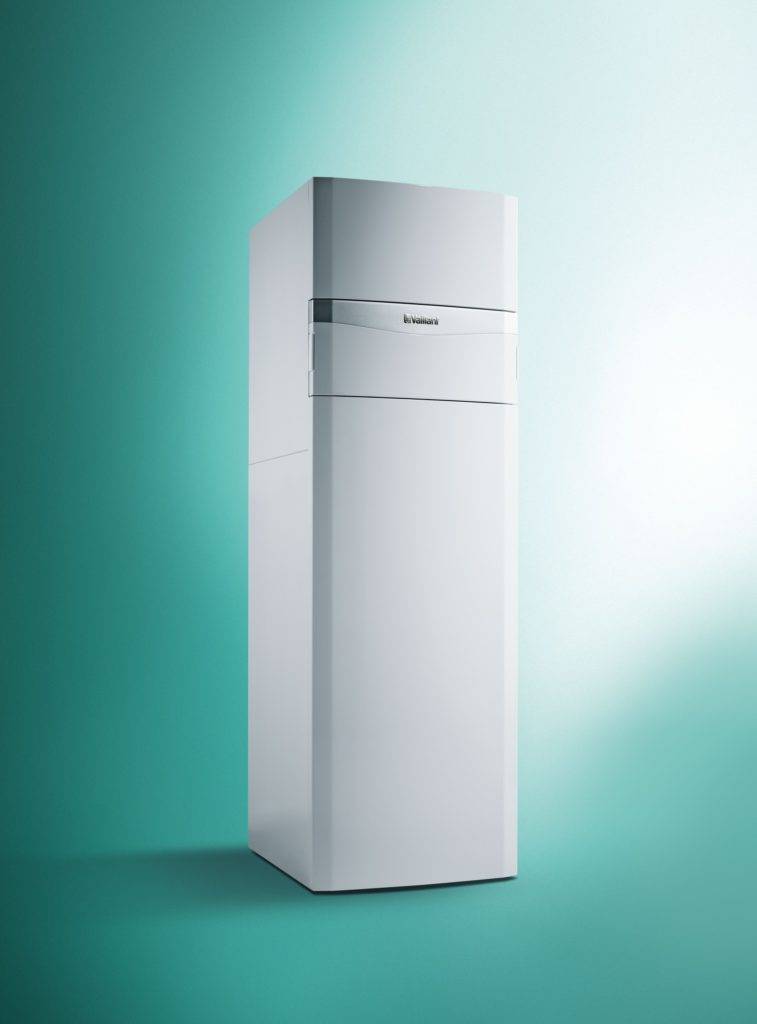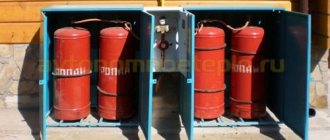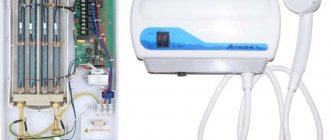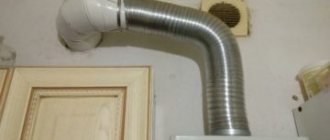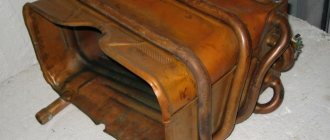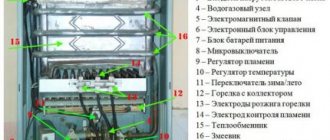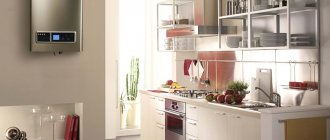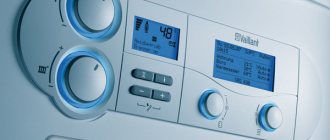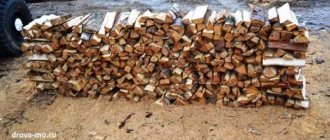Terms of use
The rules for using gas equipment in a domestic environment are not complicated, but must be followed for the purpose of safe operation:
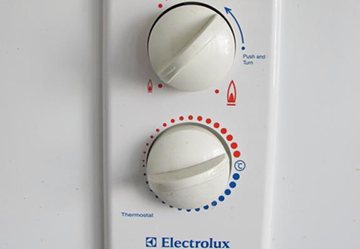
- in the room with the installed gas water heater, there must be a ventilation duct, and free access of fresh air is provided;
- before turning on the equipment, it is imperative to check the chimney draft by means of a lighted match;
- operation of gas equipment is strictly prohibited if there is no sufficient draft in the chimney;
- you must not leave a lit burner in the gas column without proper supervision of the equipment;
- it is forbidden to leave an open valve in the column under conditions of an unlit pilot burner.
A sudden cessation of the gas supply requires the immediate closing of the burner valve in the gas column.
It is important to remember that the rules for using the gas water heater are strictly prohibited from carrying out any independent repair work, as well as reinstalling this type of equipment with your own hands.
How to check the traction of a gas water heater
Equipment with an open combustion chamber needs a proper chimney arrangement and good draft.
Almost all modern models are equipped with an automatic safety system that prevents equipment from starting in the absence of traction.
As a rule, a competent thrust check involves the mandatory use of a special measuring device that helps to verify the presence of air traffic and determine the thrust force. In the absence of such a device, the following check can be performed:
- remove the horizontal part of the chimney from the entrance to the mine channel and fix the paper strips, the movement of which will signal the presence of draft;
- light a match, then direct it vertically towards the viewing window on the front panel of the gas water heater. The deflection of the match flame indicates sufficient draft.
In the absence of draft in the chimney, it is strictly forbidden to operate the gas burner.
The main ways to turn on gas water heaters
To date, various options for switching on gas water heating equipment are practiced, the choice of which directly depends on the design features of the device.
In any case, before turning on the gas column, it is required to take a number of measures that will allow the smooth operation of such equipment. It is imperative to open the taps for supplying fuel and water to the water heating device system.
How to light a gas water heater: manual ignition
This method of ignition is practiced when operating outdated models of gas water heaters and involves lighting the wick with matches.
The manual ignition technology is simple, and consists in opening the water supply system connected to the water heating equipment and the main gas supply valve, after which the wick is ignited.
A decrease in the water pressure is not accompanied by a shutdown of the device, therefore shutdown is also carried out manually.
Piezo ignition
The presence of a piezo ignition in the gas column greatly facilitates the operation and maintenance of such equipment.
The wick in such designs is ignited by pressing a special button. The ignition of the main gas burner requires the regulator to be switched on to the gas supply.
Pressing the button generates a spark and ignites the wick.
In models with piezo ignition, the location of the regulator in the initial position and the shutdown of the water supply does not extinguish the ignition wick, and the main disadvantage of such equipment is the increased fuel consumption.
Auto turn on
Today, gas water heating equipment is presented in a wide range, and improved convenient models with an automatic system for lighting the wick and ignition of the main burner have become especially popular among consumers.
As a rule, such columns have an installed turbine driven by water pressure.
Starting the turbine causes automatic operation, but in this case, rather high requirements are imposed on the water pressure in the system.
Condensing equipment
Condensing boilers from the Wilant company are especially popular due to their economy, high efficiency and excellent heating efficiency.
EcoTEC plus series VUW 246-346
This wall-mounted, double-circuit condensing unit has a built-in VRC 370 programmer, which allows different heating modes to be set one week in advance. In addition, the operating instructions highlight the following technical features and operational characteristics of this heating boiler:
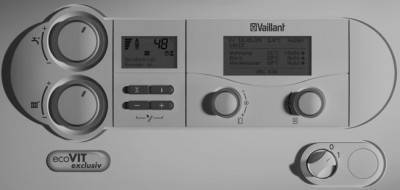

- Efficiency - 104%;
- Power range of 24, 30 and 34 kW.
- Electronic flame modulation allows smooth power gain (from 28 to 100%).
- High environmental friendliness: the carbon dioxide content in exhaust products is less than 20 mg / kWh.
- The built-in siphon allows condensate to be drained off without any problems.
- High-tech stainless steel heat exchanger.
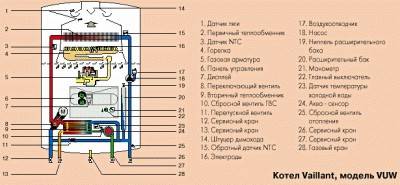

This double-circuit condensing boiler is assembled at the Vaillant plant in Germany. Modern electronics has a self-diagnosis function and displays all information about a malfunction on a display located under the protective cover.
EcoCOMPACT VSC 206-306 / 4-5 Series
The Vilant floor-standing boiler of this series is optimal for heating a small private house or cottage with an area of up to 300 sq. m. This combined unit has the following technical characteristics and design features:
- The main difference is the built-in water heater for layered water preparation.
- High efficiency of condensing equipment - 109%.
- The plate heat exchanger and the gas burner are made of hardened stainless steel.
Review: how to turn on the gas water heater
Almost all modern models are characterized by the presence of the main mandatory elements, represented by:
- node with gas equipment;
- water connection unit;
- smoke exhaust system;
- electrical appliances.
Depending on the design features, the inclusion of a gas water heater from different manufacturers may vary slightly.
Bosch
The German manufacturer accompanies the sold equipment with intuitive instructions.
All models with the "B" index in the name are equipped with an electric ignition.
Before starting, it is required to open the water and gas valves, and also check for the presence of an R type battery with a power rating of 1.5V.
The equipment is switched on by pressing the power button, which is located on the front panel.
Neva
All gas columns "Neva" are already fully tuned to a certain type of fuel and gas pressure.
To turn it on, you will need to install an LR20 battery with a voltage of 1.5V into the battery compartment, after which the shut-off valves in front of the device are opened, and the toggle switches are set to the minimum position.
The gas regulator knob on the front panel is moved to the “Ignition” position, recessed to the limit, after which the power button is pressed.
Electrolux
After visually checking all the connections on your Electrolux model for leaks, the tap opens and the water is slightly drained.
Then the gas valve opens, which is accompanied by the characteristic sound of a gas jet entering the system.
The pressure should be about 0.15-10 atmospheres. To get the water a little hotter, you will need to lower the water flow.
Aster
The burner at the gas water heater of this model is located under the central union.
This is not the most convenient version of hot water equipment to operate.
To turn on the device, move the handle to the left, press the power button and, holding it in this position for a few seconds, ignite the igniter.
Junkers
The rules for switching on hot water equipment manufactured under this brand directly depend on the features of the model.
When marking "P", piezo ignition is used, in which power indicators and water pressure are regulated by knobs on the front panel.
Marking "B" assumes ignition from batteries and automatic operation.
A special feature of models marked "G" is automatic ignition by the Hydro Power system.
General Information, Product Features, 1 Notes on Documentation
Page 3
- Picture
- Text
3
Operating instructions MAG pro 835292_02
general information
MAG pro devices are ready to connect. They only need to be connected to the pipelines and the flue gas system. They serve to supply hot water to one or more taps, such as washbasins, showers and bathtubs. The devices must be connected to a natural draft flue system (chimney). They are equipped with a maintenance-free piezoelectric igniter for the pilot burner. All gas instantaneous water heaters are equipped with an overturning draft sensor (sometimes also called a sensor for the release of combustion products into the room), which interrupts the gas supply to the burner in the event of a malfunction in the gas pipeline. The devices can be adapted to the type of gas available. To convert the device to a different gas type, contact a Vaillant-certified specialist from a specialized licensed company.
After installation, the installer noted the exact designation of your device in the installation manual in table. 10.2 "Setting parameters depending on the type of gas".
Distinctive characteristics of the product
The maximum performance of the device can be infinitely adjusted depending on the need by presetting the power. These characteristics provide the user with the following advantages: - The device only consumes as much gas as
is really required at the moment.
- The use of mixers with thermostats and
single lever mixers are possible without restrictions.
1 Notes
to
documentation
The following instructions are intended as a guide to all documentation. Other documents apply in conjunction with these operating and installation instructions. We do not accept any responsibility for damage caused by failure to follow these instructions.
Jointly valid documentation
For professionals: - Installation instructions
№ 835292
Other instructions also apply for all used spare parts and accessories.
1.1 Storage
documentation
Keep these operating instructions and all accompanying documents so that they are within easy reach when needed. When you move or sell the device, pass the documentation on to the next owner.
1.2 Used
symbols
Observe the safety instructions in these operating instructions when operating the device!
Dangerous!
Immediate danger to health and life!
Attention!
Potentially hazardous situation for equipment and the environment!
Note!
Helpful hints, information and instructions.
• A symbol that an action is required.
1.3 Type
devices
You can determine the type of installed device based on the designation in section 10 "Technical data" in the installation manual, which the installer writes down upon completion of installation.
general information
Distinctive characteristics of the product
Notes on documentation 1
No image, show text version
Gas column device
Each user should know the principle of operation of the equipment that he installs in his home. This ensures correct and safe operation.
The column consists of a metal case and:
- gas unit;
- water unit;
- hoods;
- radiator (heat exchanger);
- burners;
- work control sensors.
The principle of operation of all columns "Electrolux", "Neva", "Beretta" is the same:
- When turned on, water begins to flow into the system.
- Under pressure, the diaphragm expands and opens the gas supply valve.
- The burner ignites and heats up the liquid that circulates through the heat exchanger.
- Combustion products are discharged through ventilation and chimney.
It is believed that installing gas water heaters in an apartment or house is an unsafe business. This was the case in the days of manual firing models. Today, manufacturers are equipping equipment with sensors that monitor the presence of traction, water heating in order to prevent an emergency. But still, you should not neglect the safety rules.
If you smell gas:
- Shut off the gas supply immediately.
- Ventilate the room.
- Do not connect electrical appliances until the room is completely ventilated.
- Contact the gas service.
atmoMAG exclusiv 14-0 RXI
flowing, gas; installation type: wall-mounted, vertical; max. heating temperature: + 70 ° С; productivity: 14l / min; nomin. power: 24.4 kW; ignition: from batteries; chimney diameter: 130mm; dimensions: 350x695x259mm; weight: 14kg.
flowing, gas; installation type: wall-mounted, vertical; max. heating temperature: + 55 ° С; productivity: 14l / min; rated power: 24.4 kW; ignition: piezo; chimney diameter: 130mm; dimensions: 350x695x259mm; weight: 14kg.
Operating rules
This guide will help you to turn on your open speaker:
- During the installation of equipment, it is important to make ventilation.
- You cannot start the device if there is poor draft in the chimney or there is none at all.
- The burner must not be left unattended when it is on.
- It is forbidden to make changes to the structure yourself.
- It is not allowed to leave the valve open when the burner is not ignited.
Important! Relocation and reinstallation of equipment can only be performed by a specialist.
Traction check
Before igniting an open column, be sure to check the presence of draft. It will not be if the chimney is clogged with soot and debris. In this case, carbon monoxide can extinguish the burner and enter the room. The latest models from Bosch, Junkers, Vaillant are equipped with a protection system. It turns off the equipment or does not allow starting in the absence of traction.
To do a self-check, do this:
- Light a match or candle and bring it to the control window. The flame deflects - there is a thrust. Burns evenly - no.
- If there is no window, remove the cover of the device and bring fire to the chimney. The result is described above.
It happens that everything is in order with the chimney, but there is no draft. The reason for this is the lack of natural ventilation in the room. If you have plastic windows, install a special ventilation valve.
Self-launch
There are several ways to ignite the gas column burner.
Manual way
Used in rare copies of the old model. Not very comfortable and safe.
- A tap opens on the water pipe, which is supplied to the column.
- The gas supply valve opens.
- The wick is ignited with matches.
- The main fuel supply valve turns on.
It is important that in this case the device will not turn off as soon as you turn off the tap. You need to disable it manually.
Piezo ignition
Semi-automatic device without batteries. To light the burner, you need to get a spark. For this:
- Open fuel supply.
- Press the piezo ignition key.
- After the wick has lit, set the desired values on the thermostat.
Do not forget to supply water to the system, otherwise the heat exchanger will burn out.
The device is started in a similar way:
- The water and gas supply opens.
- The regulator is installed on the body in the "On" position.
- Then it is transferred to the "Piezo ignition" indicator.
- After the contacts are triggered, a spark is struck.
- The trigger is held down with a finger until the flame is normally ignited. Then the required power is released and set.
The wick burns constantly. When the mixer is opened, the column starts heating. To turn off the burner, the regulator is set to the OFF position.
The disadvantage of such a system is the high fuel consumption with constant burner operation.
Automatic start
The latest models "Beretta", "Ariston", "Bosch" and others are equipped with such ignition. Batteries are inserted into a special compartment. The gas valve opens. It is enough to open the mixer for operation. Then the batteries give a spark, ignition occurs.
A similar ignition is performed with a water turbine installed. When the mixer is opened, the water spins the turbine, which generates electricity to ignite the burner. The disadvantage of such a system is that with a reduced pressure in the line, the turbine will not start or give a weak heating.
This is how the column starts up. Observe safety precautions during operation, and entrust the installation to professionals.
cosmo-frost.ru
Technical features of Vaillant boilers
The characteristics of the species diversity of boilers can be characterized using as an example the most common model for the Russian consumer - this is Vaillant turboTEC pro VUW INT. Such a gas water heater belongs to simplified models in design and works in combination with forced ventilation.
The list of characteristic parameters is shown in the table below.
| Temperature level maximum | + 85 ° C |
| Maximum level of heated water in DHW | + 65 ° C |
| Circuit pressure level, maximum | 10 atmospheres |
| Gas quantity for work | 2.9 m3 / h |
| The amount of liquefied gas for work | 2.2 kg / h |
| Electricity consumed for work | 145 watts |
| Device weight | 40 kg |
| Burned raw material temperature | + 130 ° C |
The device has additional functions thanks to a built-in unit that controls the pressure level in the main pipe. There is also a special device that protects the device from possible voltage surges, while maintaining its operation in a stable state.
Video presentation and disassembly of the boiler vaillant
Specifications
Geysers Vaillant from the German manufacturer differ in a wide range of power indicators. The models are available with a power that varies between 10-30 kW. Based on this parameter, you can choose the most suitable option for providing hot water supply from 1 to 4 water intake points. In addition, the efficiency and speed of heating the liquid depends on this parameter.
When choosing a Vilant gas column, the dimensions of the device should be taken into account, not all modifications are suitable for installation in a small room. Among other things, the weight of the device plays a huge role during installation. Install the appliance on a solid, preferably load-bearing, wall capable of withstanding the weight of the device itself and the water circulating through the heat exchanger.
Two main types of units are supplied to the technical market, which differ in the type of ignition. Devices are produced with the following elements that bring the equipment into operation:
- piezo ignition - in order for the unit to start functioning, you need to press a special key;
- electric ignition - the burner is triggered by a spark formed as a result of the operation of the batteries when the pressure of hot water is opened.
Each of the options has both advantages and disadvantages. In the first case, the advantages of the device are in an affordable price, the disadvantages are the increased amount of gas consumed and the inability to start the unit at a distance beyond an arm's length. To make the equipment work, you need to press a key on it, at this moment the piezoelectric element produces a spark and the wick is ignited. But despite these nuances, the series is considered the most popular.
Models of water heaters with piezo ignition
| Gas column Vaillant MAG OE 11-0 / 0 XZ C + H - price 15,250 rubles. | Geyser Vaillant MAG OE 14-0 / 0 RXI H - 25 480 rubles. |
The second option is convenient in that the user does not have a regular need for contact with the equipment, it is enough just to open the tap, and the Vilant gas column will begin to heat the water. The disadvantage of the machine is that the batteries tend to be discharged and will need to be constantly replaced, and this is an additional cost and hassle. Despite this, the device is considered more convenient and economical to use.
Mag pro, Instruction manual, Table of contents
Page 2
- Picture
- Text
For the user
Manual
MAG pro
Operating instructions MAG pro 835292_02
2
Table of contents
General information . ... ... ... ... ... ... ... ... ... ... ... ... ... ... ... ... ... ... ... ... ... ... ... ... ... ... ... ... 3
Distinctive characteristics of the product. ... ... ... ... ... ... ... ... ... ... ... ... 3
1
Instructions for documentation. ... ... ... ... ... ... ... ... ... ... ... ... ... ... ... ... ... ... 3
1.1
Storage of documentation. ... ... ... ... ... ... ... ... ... ... ... ... ... ... ... ... ... ... ... ... ... ... ... ... 3
1.2
Symbols used. ... ... ... ... ... ... ... ... ... ... ... ... ... ... ... ... ... ... ... ... ... ... ... ... 3
1.3
Device type. ... ... ... ... ... ... ... ... ... ... ... ... ... ... ... ... ... ... ... ... ... ... ... ... ... ... ... ... ... ... ... ... 3
2
Safety precautions. ... ... ... ... ... ... ... ... ... ... ... ... ... ... ... ... ... ... ... ... ... four
3
Installation and operating instructions. ... ... ... ... ... ... ... ... five
3.1
Manufacturer's warranty. Russia. ... ... ... ... ... ... ... ... ... ... ... ... ... five
3.2
Intended use. ... ... ... ... ... ... ... ... ... ... ... ... ... ... ... ... ... ... five
3.3
Installation site requirements. ... ... ... ... ... ... ... ... ... ... ... ... ... ... ... ... ... ... ... 6
3.4
Leaving. ... ... ... ... ... ... ... ... ... ... ... ... ... ... ... ... ... ... ... ... ... ... ... ... ... ... ... ... ... ... ... ... ... ... ... ... ... ... ... ... ... 6
3.5
Disposal of packaging and apparatus. ... ... ... ... ... ... ... ... ... ... ... ... ... ... ... ... ... 6
3.5.1 Device. ... ... ... ... ... ... ... ... ... ... ... ... ... ... ... ... ... ... ... ... ... ... ... ... ... ... ... ... ... ... ... ... ... ... ... 6 3.5.2 Packaging. ... ... ... ... ... ... ... ... ... ... ... ... ... ... ... ... ... ... ... ... ... ... ... ... ... ... ... ... ... ... ... ... ... ... ... ... ... 6 3.6
Energy saving tips. ... ... ... ... ... ... ... ... ... ... ... ... ... ... ... ... ... ... ... 6
4
Exploitation . ... ... ... ... ... ... ... ... ... ... ... ... ... ... ... ... ... ... ... ... ... ... ... ... ... ... ... ... 7
4.1
Overview of controls. ... ... ... ... ... ... ... ... ... ... ... ... ... ... ... ... ... ... ... ... ... 7
4.2
Preparing the device for operation. ... ... ... ... ... ... ... ... ... ... ... ... ... ... ... ... ... 7
4.3
Commissioning. ... ... ... ... ... ... ... ... ... ... ... ... ... ... ... ... ... ... ... ... ... ... ... ... ... ... ... 7
4.3.1 Ignition of the pilot burner. ... ... ... ... ... ... ... ... ... ... ... ... ... ... ... ... ... ... ... ... ... ... 7 4.3.2 Setting readiness for operation. ... ... ... ... ... ... ... ... ... ... ... ... ... ... ... ... ... ... 8 4.4
Preparing hot water. ... ... ... ... ... ... ... ... ... ... ... ... ... ... ... ... ... ... ... ... eight
4.4.1 Disassembly of hot water. ... ... ... ... ... ... ... ... ... ... ... ... ... ... ... ... ... ... ... ... ... ... ... ... ... ... ... 8 4.4.2 Pulling cold water or mixing
cold water. ... ... ... ... ... ... ... ... ... ... ... ... ... ... ... ... ... ... ... ... ... ... ... ... ... ... ... ... ... ... ... nine
4.4.3 Adjusting the water temperature. ... ... ... ... ... ... ... ... ... ... ... ... ... ... ... ... ... ... 9 4.5
Power presetting. ... ... ... ... ... ... ... ... ... ... ... ... nine
4.6
Trouble-shooting . ... ... ... ... ... ... ... ... ... ... ... ... ... ... ... ... ... ... ... ... nine
4.7
Disconnection. ... ... ... ... ... ... ... ... ... ... ... ... ... ... ... ... ... ... ... ... ... ... ... ... ... ... ... ... ... ... ... ... ... ... 10
4.7.1 Disable readiness for work. ... ... ... ... ... ... ... ... ... ... ... ... ... ... ... ... 10 4.7.2 Closing the shut-off valves. ... ... ... ... ... ... ... ... ... ... ... ... ... ... ... ... ... ... ... ... 10 4.8
Frost protection. ... ... ... ... ... ... ... ... ... ... ... ... ... ... ... ... ... ... ... ... ... ... ... ... ... ... 10
4.9
Maintenance . ... ... ... ... ... ... ... ... ... ... ... ... ... ... ... ... ... ... ... ... ... 10
